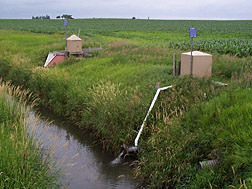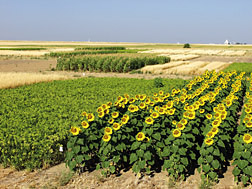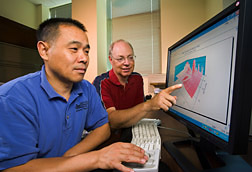Get Into the Zone . . . The Root Zone
|
|
Deep in the agricultural underworld, the futures of fields are decided by a series of interactions that unfold beyond our sight—but not beyond our control—in the root zone. This area immediately surrounding a plant’s roots is the site of physical, chemical, and biological activities that affect the plant’s growth and its influence on the environment.
Smart management of root zones can have economic and ecological benefits. To help growers make well-informed decisions, ARS scientists in the Agricultural Systems Research Unit at Fort Collins, Colorado, developed the Root Zone Water Quality Model (RZWQM). Recent improvements to the model have increased its scope and accuracy.
RZWQM is a computer model that simulates plant growth and the movement of water, nutrients, and chemicals within and around the root zones of agricultural crops. It helps growers evaluate how management practices influence runoff, groundwater quality, water conservation, and crop yields.
By entering information about their cropping systems, growers and consultants can estimate the environmental and economic impacts of a variety of management decisions, such as tillage, crop residue management, crop rotations, and the timing and rate of chemical application.
The first version of RZWQM was released in 1992. Over the last 4 years, Fort Collins scientists have developed RZWQM2, an enhanced version designed to serve a larger audience with greater ease.
In the Zone
Initially, RZWQM was used in the Great Plains, Midwestern United States, and countries such as Canada, Germany, Portugal, and China. But the model had limitations.
As RZWQM’s popularity increased, new users contacted the Fort Collins researchers and requested changes and enhancements to meet their specific needs. The result is the multifaceted RZWQM2.
“The model provides a whole-system approach,” says research leader Laj Ahuja. “It’s not the only comprehensive root zone model, but it is unique in assessing the effects of agricultural management practices—such as tillage, tile drainage, and crop residue cover—on water quality and crops.”
The new version has a Windows XP interface, making it more user friendly than the earlier model, which used Windows 98. The new interface has been modified to allow input on more components, such as new crop-modeling technology and tile, or subsurface, drainage.
Responding to requests from field scientists, Ahuja and his colleagues linked the model to existing crop-growth models—CERES, CROPGRO, and SHAW—to improve water and plant-growth simulations. This increased the number of crops to which the simulations could be applied. The team also extended RZWQM’s application to about 30 meters beyond the root zone and improved the way it models the flow of shallow groundwater to tile drains.
“These changes helped improve the accuracy of the model’s assessments of tile drain flow and water quality,” Ahuja says.
Many Fort Collins researchers contributed to the development and improvement of RZWQM2, including soil scientist Liwang Ma, hydraulic engineer James Ascough, hydrologist Tim Green, and IT specialist Ken Rojas (now with the USDA Natural Resources Conservation Service). Agricultural engineer Robert Malone of ARS’s National Soil Tilth Laboratory in Ames, Iowa, and Colorado State University scientist S.A. Saseendran were also highly influential.
In 2006, the scientists received an ARS Award for Superior Technology Transfer and were nominated for a Federal Laboratories Consortium National Award for Excellence in Technology Transfer. Both awards recognize scientists for developing new technology and bringing it to the public.
|
|
A Who’s Who of RZWQM2
Who’s using this model? A diverse crowd from all over the world, Ahuja says. In fact, the model has been downloaded more than 1,000 times since it became publicly available in 1995.
RZWQM2 is not without its faults. The model’s website notes some limitations, particularly the fact that it is a one-dimensional model, meaning it only plots the vertical movement of water and chemicals. Nevertheless, RZWQM2 has a loyal following.
Many agencies and groups have written to Ahuja and Will Blackburn, ARS director of the Northern Plains Area, extolling the benefits of the enhanced RZWQM2.
“The changes that have been made to the model have had incredible benefits, and not just for ARS labs and field scientists,” Blackburn says. “The Environmental Protection Agency (EPA), the U.S. Geological Survey (USGS), and researchers around the world are using this technology to evaluate the effects of agriculture and management on crop production and water quality to attain sustainable systems.”
EPA regulators have proposed using RZWQM2 to estimate pesticide concentrations in areas prone to contamination. The model allows them to include in their calculations preferential flow, water tables, depth to groundwater, and agricultural management practices, which earlier methods had not taken into account.
The recent improvements to RZWQM2 “filled a need that EPA has had for years,” said Dirk Young, of the EPA, in a 2005 correspondence to Blackburn. “The end result of Dr. Ahuja’s efforts will be improved pesticide exposure and risk assessments, especially in regard to our ability to protect important drinking-water resources.”
The EPA isn’t the only agency to appreciate the model’s updates. After testing it against six other models, the USGS selected RZWQM2 as the most effective and is now recommending it for use in their National Water Quality Assessment Project. Pesticide company Bayer Crop Science has used it to perform simulations and to register pesticides with the EPA.
University of Manitoba researcher Ross McQueen has used RZWQM2 to compute potential pesticide contamination of surface and groundwater in Canada. And researchers in China have used it to study water and nitrogen management in the North China Plain. Guided by the model, they were able to cut water and nitrogen application rates in half.
“Models can be an incredibly vital agricultural resource,” Ahuja says. “I’m delighted that RZWQM2 has been able to serve such a broad and diverse group of people.”—By Laura McGinnis, Agricultural Research Service Information Staff.
This research is part of Water Resource Management (#201) and Integrated Agricultural Systems (#207), two ARS National Programs described on the World Wide Web at www.nps.ars.usda.gov.
Lajpat R. Ahuja is in the USDA-ARS Agricultural Systems Research Unit, 2150 Centre Ave., Fort Collins, CO 80526-8119; phone (970) 492-7312, fax (970) 492-7310.
"Get Into the Zone . . . The Root Zone" was published in the March 2007 issue of Agricultural Research magazine.









